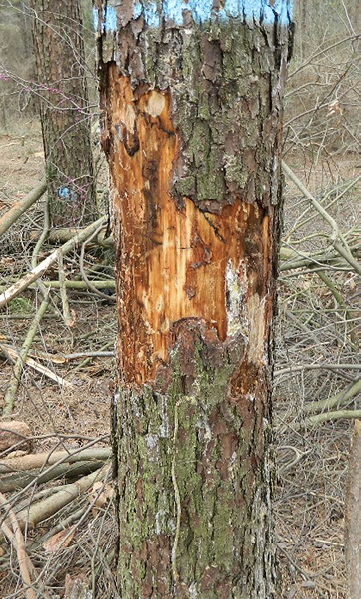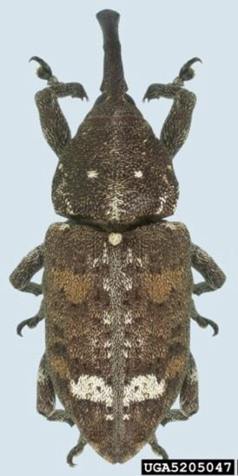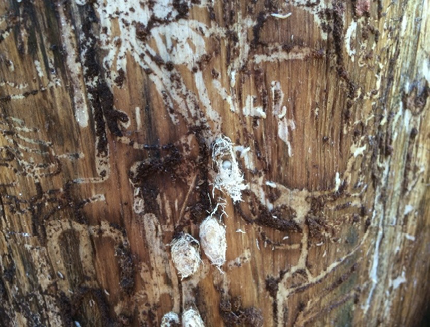What Is Attacking My Pine? The Case of the Deodar Weevil
Many pine owners are able to identify the damage caused by southern pine beetles (Dendroctonus frontalis) (SPB) or Ips engraver beetles (Ips spp.). Many, however, have never heard of the deodar weevil (Pissodes nemorensis) unless they have experienced an outbreak on their property. Fortunately, this native insect leaves very distinctive signs and tree symptoms that landowners can use to survey their pines for this pest.
Deodar weevils are native insects that attack a variety of conifers including all loblolly (Pinus taeda), longleaf (P. palustris), shortleaf (P. echinata), and slash (P. elliottii). In response to deodar and other insects, pines have developed natural defenses that effectively prevent attacks when trees are healthy and growing rapidly. During most years, these weevils only attack a few suppressed, unhealthy trees that are scattered in well-managed plantations. As such, the deodar weevil is not an insect that regularly alters traditional pine management.
Pine owners should be mindful of the risk deodar weevils can pose under certain sets of environmental conditions. Being able to differentiate deodar damage from that of other insect pests is important for proper stand management. Rapid identification of a deodar outbreak can help guide post-attack management treatments and reduce future damage. The goal of this publication is to help forest landowners identify deodar weevils and develop a plan to prevent or moderate damage to pine plantations.
Conditions Favoring Outbreaks
Tree stress is an important factor in deodar weevil outbreaks. Deodar outbreaks during late summer droughts can be as devastating as those caused by Ips engraver beetles; however, droughts rarely lead to outbreaks because the weevils also require favorable breeding conditions (warm fall temperatures) the previous year. Nevertheless, when this combination of factors occurs, deodars, along with Ips engraver beetles, are capable of killing large numbers of stressed pines (Figure 1). Factors besides drought that increase the risk of outbreak by inducing tree stress include overly stocked pine stands and wind, hail, or logging damage the preceding fall. Stands heavily fertilized with nitrogen or located near chicken houses also seem to attract deodars.

Landsat image via Google Maps, Copiah County, 2016.
Associations with Pitch Canker
Deodar weevils are vectors of pitch canker (Fusarium moniliforme). Although deodars are capable of disseminating pitch canker in all seasons, the majority of spread occurs in the fall, when fungus-carrying weevils bore into trees to reproduce. It is important to note that not all weevils carry the fungus. Deodars must first pick up the fungus from an infected tree before it can spread to a healthy pine. Pitch canker kills a small area of stem or branch, causing it to exude large amounts of sap or pitch. As such, pitch running down stems and branches is a key symptom of pitch canker (Figure 2). The combination of pitch canker and deodar weevils can be lethal in pine plantations, with reports of 40 percent top dieback and 30 percent mortality occurring in a single year.

Photos by Stephen Dicke, Leake County, 2012.
Life Cycle
The life cycle of deodar weevils begins in the spring (April to May) with adults inside wood chip cocoons under pine stem bark (Figure 3). Adults (Figure 4) bore out of the tree and begin feeding on succulent tops and lateral branches of pine trees (Figure 5). Adult activity is diminished during summer heat. Adults become active again in cooler fall temperatures. Fall is the peak time for adult feeding and breeding. Deodars prefer stressed, dying, or dead trees for breeding. Often, they seek trees that have been previously attacked by SPB or Ips. Slash can also be used for reproduction. Female adults puncture the bark with their snouts and typically lay between one and four eggs inside each feeding puncture. Legless, white, grub-like larvae with brown heads hatch and mine random paths under bark over the course of fall and winter. It is this larval feeding that ultimately can girdle and kill the tree (Figure 6). Trees dying in the winter may indicate a heavy deodar infestation. By February to March, larvae have grown to one-fourth of an inch long. Larvae then surround themselves with half-inch, football-shaped wood chip cocoons. By April, larvae pupating inside chip cocoons slowly change into adults (Figure 7). This month-long pupation period is when deodar weevils are most vulnerable to predation. The pupation period also gives landowners an opportunity to identify and control this pest.

Photo by Stephen Dicke, Walthall County, 2016.

Photo by Natasha Wright, Cook’s Pest Control, Bugwood.org.

Photo by Stephen Dicke, Adams County, 2015.

Photo by Stephen Dicke, Leake County, 2016.

Photo by Stephen Dicke, Copiah County, 2016.
Deodar Weevil Identification
Like all weevils, adult deodar weevils are easy to distinguish from other wood-boring insects. Look for their long snouts with antennae (Figure 4). Body color ranges from gray to reddish-brown, with white spots for camouflage. Deodar weevil adults average a quarter-inch in length resulting in an insect much larger than Ips engraver beetles or SPB, and similar in size to the black turpentine beetle (Dendroctonus terebrans).
Signs and Symptoms of Deodar Weevils
Fading Tree Crowns and Dying Tops
Fading crowns in the fall or winter are a common symptom of deodar weevil activity (Figure 5); however, this symptom alone does not confirm presence of a deodar infestation—or any other insect, for that matter. Instead, crown fade simply indicates stress, which can be caused by a variety of factors. Following fading, pine tops can die, and, ultimately, the stem can die if damage is great enough (Figure 1). Crowns fading in late spring and summer are most likely caused by something other than deodar weevils.
Chip Cocoon
The most definitive sign of a deodar infestation is the chip cocoon (Figure 3). Created by larvae in preparation of their pupation, cocoons are visible as early as February. Deodar weevils tend to occupy the bottom 10 feet of the main stem, so cocoons are relatively easy to spot. Bark can also slip off heavily infested stems, exposing the chip cocoons. Intact cocoons mean larvae and pupae are still inside. There is still time to control this population of weevils.
Once cocoons are found, pay close attention to the existence of an exit hole and its shape. Cocoons with perfectly round exit holes indicate a successful adult deodar emergence (Figure 3). Imperfect exit holes are a good sign for landowners. Cocoons that appear to be ripped open are indicative of woodpeckers (Picidae spp.) preying on larvae and pupae (Figure 8). Birds are an important natural control agent of deodar populations.

Photo by Stephen Dicke, Rankin County, 2016.
Deodar Weevil Risk
Loblolly pine is the most common host for deodar weevils, but all pine species in Mississippi can be attacked. Pure stands of pine are at greater risk of deodar weevil outbreaks than mixed stands of pine-hardwood. The risk of attack by deodar weevils begins about age 5, when stems are large enough to support larval galleries. Pines at that age are also very sensitive to mortality from crown damage. Risk of attack peaks for pine plantations before the first thin, when resource competition begins to reduce tree vigor. After the first thinning, risk of deodar attack drops. Carefully scout your pine plantation following summer to fall droughts, wind and hail storms, and fall logging damage. Also scout pine plantations adjacent to chicken houses and in plantations heavily fertilized with nitrogen.
Finding some signs of deodar weevils is not of great concern. This is because deodars do not kill healthy pine trees. Thus, immediate action is rarely required.
Preemptive Management
The best way to prevent a deodar outbreak is to maintain a vigorously growing plantation. Rapidly growing pines are typically healthy and will have ample resin flow to cover and kill newly hatched larvae. For this reason, adult beetles do not usually lay their eggs on healthy pines.
It is perfectly normal to have suppressed, unhealthy trees scattered throughout a plantation before a thinning. Landowners should not be concerned if deodar signs are found on these suppressed trees. In fact, suppressed tree mortality may actually be beneficial, as it releases better trees from competition. In addition, unlike SPB or Ips engraver beetles, deodar infestations will not actively spread throughout the growing season.
Landowners should focus on thinning to maintain tree vigor. As a general rule of thumb, landowners should schedule thinning once tree diameter growth falls below an annual threshold of 5 percent. Egg-laying females usually avoid pines growing at 5 percent or greater. Thus, thinning will help keep your stand safe in the event of a deodar outbreak.
One factor landowners should be aware of is residual damage after thinning. Trees damaged in thinning operations typically become stressed, increasing risk of deodar attack. Fortunately, much of this risk can be overcome by thinning either before or after the peak breeding season (September to November). For more thinning guidance, see MSU Extension Publication 2260 Are My Pines Ready to Thin? or Information Sheet 2010 Simplifying Southern Pine Thinning with Stand Density Index, and download the Guide to Thinning Southern Pines smartphone app. These items are available at extension.msstate.edu.
A sound strategy for preventing deodar damage is to plant pines on sites where they are best suited to grow. Compared to most hardwood species, pines have a relatively wide range of sites on which they can be planted. However, even pines have their limits. Planting a pine on the wrong site increases stress and decreases vigor. For more information on pine site considerations, see Extension Publication 1776 Planting Southern Pines: A Guide to Species Selection and Planting Techniques.
Summary
Although deodar weevil outbreaks are rare, it is important to remember the destructive potential of this insect. This is particularly true for young pine plantations, where risks are elevated. In most years, deodar weevils pose only a minor threat to pine plantations. This is because healthy pines are able to resist attack. Also, deodar weevils have only one generation per year, reducing potential for an expanding attack. Therefore, signs of deodar attack on suppressed pines is not a major concern. Stresses that can lead to deodar outbreaks include climatic events such as droughts, wind and hail storms, logging damage, and ammonia gas from chicken houses. Scouting young pine plantations following these stressors can help identify deodar attacks. Outbreaks are still hard to predict. As such, the best way to defend against an outbreak is to maintain stand vigor. This includes planting trees on appropriate growing sites and thinning before the onset of intense competition. These basic steps will help keep pines safe.
Publication 3057 (POD-04-23)
Revised by A. Brady Self, PhD, Associate Extension Professor, Department of Forestry; from an earlier version by John Willis, PhD, former Assistant Professor; Stephen Dicke, PhD, Professor Emeritus, Department of Forestry; and John Riggins, PhD, Associate Professor, Entomology.
The Mississippi State University Extension Service is working to ensure all web content is accessible to all users. If you need assistance accessing any of our content, please email the webteam or call 662-325-2262.




